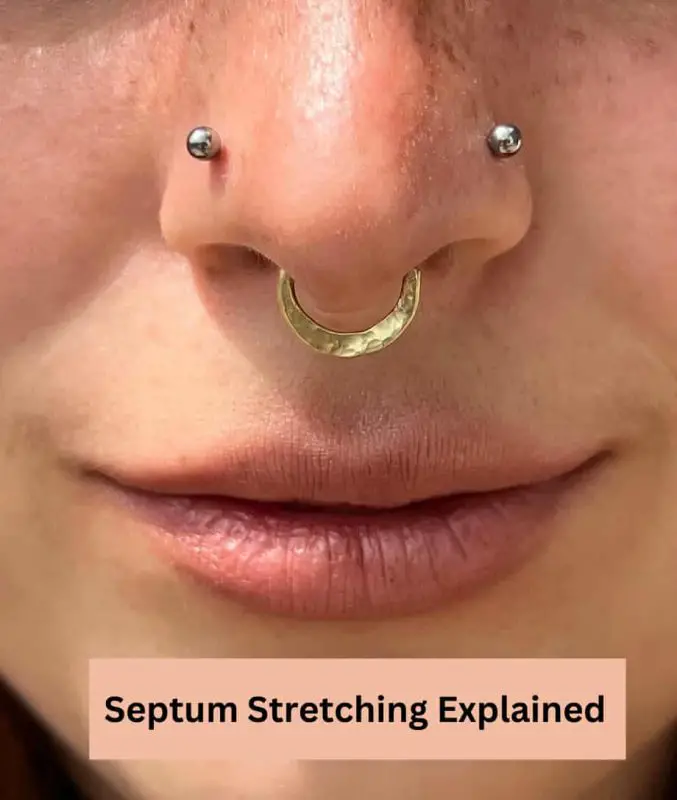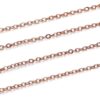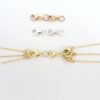Nose Piercing
Septum Stretching Explained: How to Choose the Right Jewelry, Size, and Technique
Septum stretching is a popular form of body modification that involves enlarging the hole in the cartilage between your nostrils. Many people choose to stretch their septum for aesthetic reasons, to express their individuality, or to wear larger and more diverse jewelry. However, septum stretching is not as simple as it may seem. It requires careful planning, patience, and knowledge of the best practices and techniques.
If you are interested in septum stretching, or if you have already started the process, you may have many questions and concerns. How do you choose the right jewelry, size, and technique for your septum? How do you avoid infections, blowouts, and other complications? How do you care for your stretched septum and enjoy its benefits?
That’s why we have created this comprehensive guide to septum stretching. In this guide, you will learn everything you need to know about septum stretching, from the basics to the advanced tips.
You will discover:
- What is septum stretching and how does it work?
- How to understand your septum anatomy for safe stretching
- How to stretch your septum using different methods and tools
- How to choose the right size and gauge for your septum jewelry
- How to care for your stretched septum and prevent infections and other issues
- What are the potential risks and how to avoid them
- What are the advantages of septum stretching and how to enjoy them
- And much more!
By following this guide, you will be able to stretch your septum safely and comfortably, achieve your desired look, and enjoy your personal work of art. So, let’s get started!
So, you’re intrigued by the world of septum stretching? Let’s embark on this enlightening journey together.
Contents
- 1 What is septum stretching?
- 2 The Basics of Septum Stretching:
- 3 Understanding Septum Anatomy for Safe Stretching
- 4 How to Stretch Your Septum
- 5 Stretching vs Stacking
- 6 Septum Stretching – Video Guide
- 7 Choosing the Right Size:
- 8 Selecting the Perfect Jewelry: Your Guide to Making the Right Choice
- 9 Material Matters:
- 10 3 WAYS TO SAFELY STRETCH YOUR SEPTUM
- 11 Caring for a Stretched Septum: Nurturing Your Personal Work of Art
- 12 Potential Risks and How to Avoid Them: Navigating the Waters of Septum Stretching
- 13 Advantages of Septum Stretching: More Than Just a Fashion Statement
- 14 FAQs:
- 15 Conclusion:
What is septum stretching?
Have you ever seen someone with an enlarged piercing in the middle of their nose and thought, “How did they achieve that?” Well, that’s septum stretching! It’s the process of gradually increasing the diameter of a pierced hole in the septum – that’s the thin wall dividing your nostrils. Imagine inflating a balloon bit by bit, letting it adjust to each size; it’s kind of like that but for your nose!

The cultural and modern significance of septum stretching:
Septum stretching was once a cultural ritual for many tribes, signifying milestones, courage, or status. Today, it is a form of self-expression, art, or rebellion. People who stretch their septums have different motives, such as beauty, statement, or heritage. Septum stretching shows the diversity and creativity of humanity. How fascinating!
The Basics of Septum Stretching:
History and Evolution:
The ancestral art of septum stretching:
Journey with me back in time. Ancient civilizations across the globe, from the Native American tribes to the tribes in Papua New Guinea, have practiced septum stretching. It was more than mere decoration – it was identity, heritage, and sometimes even a deterrent to adversaries. Picture warriors with fierce adornments, signifying their prowess.
Modern-day practice and adaptations:
Now, bounce back to our urban jungles. Modern septum stretching is a dance between tradition and innovation. While many engage in it for its rich history, others are drawn to its edgy, alternative appeal. And thanks to technological advancements, we now have a range of tools and jewelry options that our ancestors could’ve only dreamed of.
Understanding Septum Anatomy for Safe Stretching
Understanding the nasal septum:
Have you ever taken a moment to appreciate the marvel that is the human body?
Let’s zero in on one intricate piece of it: the septum. Nestled right in the center of our nose is the septum, a delicate partition made of both bone and cartilage. It’s this tiny wall that divides your nostrils and provides a base for our septum piercings. While it’s sturdy enough to support jewelry, it’s also sensitive, making it vital to treat it with utmost care.
Importance of knowing your anatomy for safe stretching:
Ever tried to assemble a puzzle without seeing the bigger picture? That’s what diving into septum stretching without understanding your anatomy is like. Recognizing the intricacies of your septum ensures a safer, more informed stretching journey. Why, you ask? Because when you know the lay of the land, or in this case, the structure of your nose, you’re better equipped to avoid potential pitfalls. It’s like having a GPS for your septum stretching journey, guiding you away from harm and towards a successful stretch.
The Physiology Behind Stretching:
Now, here’s where it gets interesting. When you stretch your septum, you’re not just making space for bigger jewelry. Instead, you’re encouraging the skin and cartilage to adapt and grow. It’s a gentle dance of applying pressure and allowing healing, kind of like how muscles grow with exercise. But remember, just as you wouldn’t lift excessively heavy weights on your first gym day, it’s crucial to stretch gradually, respecting the boundaries of your body.
Why Some Areas are More Sensitive than Others:
Ever noticed that some parts of your septum might feel more tender during stretching? That’s because the septum isn’t uniform. Some areas have more nerve endings, while others might be denser in cartilage. It’s this beautiful yet complex landscape that gives each person’s septum stretching journey its unique flavor. Think of it as nature’s way of reminding us that while we may tread similar paths, each experience is beautifully individual.
How to Stretch Your Septum
- Septum stretching is the process of gradually enlarging the hole in the cartilage between the nostrils by inserting larger and larger jewelry.
- To stretch your septum, you need to have a healed septum piercing that is done through the sweet spot, which is a small area of thin skin at the bottom of the septum.
- You also need to have the appropriate jewelry and tools for septum stretching, such as rings, plugs, tunnels, pinchers, spirals, tapers, tape, etc.
- The general principle of septum stretching is to increase the size of jewelry by small increments over time until you reach your desired size. You should always stretch your septum slowly, gently, and safely to avoid any complications.
- There are different methods of septum stretching, such as tapering, dead stretching, taping, and weighting. Each method has its own advantages and disadvantages, and you should choose the one that suits your preference, budget, pain tolerance, healing speed, etc.
- You should always clean your septum and jewelry before and after each stretch with saline solution or mild soap and water. You should also massage your septum with oil or moisturizer to keep it soft and supple.
- You should wait at least 4 to 6 weeks between each stretch to allow your septum to heal properly.
- Listen to your body and stop stretching if you feel any pain, discomfort, or resistance.
- You should consult a professional piercer before stretching your septum to get advice on the best size, jewelry, and technique for you.

Stretching vs Stacking
- Stretching and stacking are two different ways of modifying your septum piercing.
- Stretching involves enlarging the hole in the cartilage by inserting larger and larger jewelry. Stacking involves inserting multiple pieces of jewelry in the same hole without enlarging it.
- Stretching requires more time, patience, and care than stacking. Stacking requires more creativity, variety, and coordination than stretching.
- Stretching can change the shape and appearance of your nose permanently. Stacking can change the look and style of your nose temporarily.
- Stretching can cause more pain, bleeding, infection, scarring, or damage than stacking. Stacking can cause more irritation, pressure, or discomfort than stretching.
- Stretching can achieve a more noticeable and dramatic effect than stacking. Stacking can achieve a more subtle and versatile effect than stretching.
Septum Stretching – Video Guide
Choosing the Right Size:
Initial Size Considerations:
How to determine your starting size:
Starting your septum stretching journey might feel overwhelming, but it’s simpler than you might think. Most piercings begin with a standard size, often 16 or 14 gauge. But, as with shoes, everyone’s fit is different. A chat with a professional piercer, someone who’s seen more septums than you’ve had hot dinners, can guide you to your perfect starting point.
Common sizes and measurements in septum stretching:
Sizes in septum stretching follow a gauge system. It’s counterintuitive: the larger the number, the smaller the size. So, a 16-gauge is smaller than an 8-gauge. Common sizes include 16g (1.2mm), 14g (1.6mm), 12g (2mm), and so on. However, the journey from one size to the next should be gradual, like slowly turning up the volume on your favorite song.
The Safe Progression of Sizes:
How quickly should you go to the next size?
Ah, the age-old question! While you might be eager to jump to the next size, patience is key. Generally, waiting at least a month or more between stretches is advisable. But here’s a golden nugget for you: listen to your body. If it hurts or resists, it’s not ready. Think of it as your body’s way of whispering, “Not yet, pal.”
Recognizing signs of readiness for up-sizing:
Your septum, like a well-behaved pet, will give you signs when it’s content or agitated. Healthy skin, no pain, and flexibility often mean you’re good to go. But redness, swelling, or discomfort? Those are your stop signs. It’s all about building a bond of trust and understanding with your body. Sounds deep, doesn’t it? But trust me, it’s worth it!
Selecting the Perfect Jewelry: Your Guide to Making the Right Choice
Material Matters:
Ever stood in front of a jewelry store, overwhelmed by the choices? I’ve been there. Let’s demystify the materials, shall we?
Pros and cons of various materials:
Different materials come with their unique perks and quirks:
- Surgical Steel: Highly durable and resistant to tarnish, but might not be suitable for everyone, especially those with nickel sensitivities.
- Titanium: Lightweight and hypoallergenic, but often pricier than its counterparts.
- Glass: Non-porous and hypoallergenic, making it great for fresh stretches, but it’s breakable.
- Acrylic: Affordable and available in various colors, but not ideal for long-term wear or fresh stretches due to its porous nature.
The importance of hypoallergenic options:
Did you know some materials can irritate your skin? That’s why opting for hypoallergenic materials can be a game-changer. They reduce the risk of allergic reactions, ensuring a smoother stretching journey. After all, wouldn’t you want your septum to shine without any unsightly reactions?
Style and Design:
Fashion meets function in the world of septum jewelry!
Popular jewelry styles for stretched septums:
From sleek and simple to ornate and opulent, there’s a universe of styles to explore:
- Tunnels and Plugs: Offers a peek-through effect, highlighting the stretch.
- Pinchers: A crescent-shaped jewelry piece, perfect for those going for a tribal look.
- Tusks: Elongated and often adorned, they add a touch of the exotic.
Keeping aesthetics and safety in balance:
Remember, while style is vital, safety is paramount. Always ensure your chosen design doesn’t hinder the health of your septum. Think of it as marrying fashion with function!
3 WAYS TO SAFELY STRETCH YOUR SEPTUM
1. The Taper Method:
Often dubbed as the gateway method for most septum stretch enthusiasts, tapering is where many begin their journey.
How it Works:
- Tapers are elongated, cone-shaped tools that are thicker at one end and gradually taper down to a thinner point at the other end. They’re designed to help ease your septum from one gauge size to the next larger one.
Steps:
- Cleanliness First: Start by sterilizing the taper and your jewelry. As I always say, a clean start is a safe start!
- Lubrication: Apply a body-safe lubricant (like jojoba oil) on the taper to ensure a smooth transition.
- Gentle Push: Insert the thin end of the taper into the piercing, slowly pushing it through until you reach the thicker end. It’s like guiding your piercing to accept a larger size.
- Jewelry Insertion: Once the taper is through, follow it up by inserting the new, larger jewelry in the expanded hole.
Safety First:
Never force the taper. If you feel resistance or pain, take a pause. Remember, this method requires patience. Rushing can result in tears or blowouts.
2. The Weighted Jewelry Method:
While this method might sound like you’re letting gravity do all the work, there’s a bit more nuance to it.
How it Works:
Weighted jewelry, as the name suggests, is heavier than your average septum ring. When worn, this jewelry applies a gentle, consistent pull on the septum, encouraging a slow and natural stretch.
Steps:
- Select the Right Weight: Not too light that it’s ineffective, and not so heavy that it overburdens the septum. It’s a balance.
- Regular Monitoring: This method isn’t a “set it and forget it” deal. Regularly check to ensure the weight is stretching the septum uniformly without causing thin spots.
- Rotation: Rotate the jewelry now and then to ensure an even stretch.
Safety First:
As soothing as the gradual pull might feel, be cautious. Overweighting can lead to thinning of the septum tissue or even tears.
3. The PTFE or Teflon Tape Method:
A favorite among many for its control and gentleness. The tape method is all about precision.
How it Works:
PTFE or Teflon tape is wrapped around the jewelry, increasing its diameter gradually. Each wrap nudges the septum a tiny bit more, facilitating a controlled and incremental stretch.
Steps:
- Clean and Prep: Ensure both your jewelry and tape are clean.
- Wrap Away: Add a wrap or two of the tape around your jewelry, then insert it back into the septum.
- Consistency: Every few days, add another wrap. This ensures a slow, steady, and safe stretch.
Safety First:
The tape can harbor bacteria if left for too long. Change the tape every couple of days, and always be alert for signs of discomfort or infection.
Caring for a Stretched Septum: Nurturing Your Personal Work of Art
Daily Maintenance:
Cleaning and moisturizing:
Your septum requires some TLC! Regular cleaning with saline solutions keeps it infection-free, while occasional moisturizing (using safe oils like jojoba) maintains its elasticity.
Recognizing signs of infection or issues:
Redness? Swelling? Discomfort? These could be your body’s way of signaling a problem. Stay vigilant and when in doubt, always seek professional advice.
Long-term Care:
The effects of going up in size and downsizing:
Upsizing can be thrilling, but it’s essential to understand that going too fast can cause tears. And if you ever choose to downsize? Your septum might shrink, but depending on how large and how long it was stretched, it may not return entirely to its original size.
Ensuring elasticity and health:
Think of your septum like a rubber band. Maintaining its elasticity ensures it doesn’t become too thin or weak. Regular massages, safe practices, and listening to your body will keep it in prime condition.
Overstretching and Tears:
Ever tried to pull an elastic band too hard and too fast? Well, the septum isn’t vastly different.
The importance of patience:
I can’t emphasize this enough: Slow and steady wins the race. Overstretching can lead to painful tears, scarring, and prolonged healing times. Taking your time with each stretch, allowing the septum to heal fully, ensures a safer and more comfortable journey. After all, you wouldn’t rush art, would you?
First-aid measures for injuries:
Mistakes happen. If you experience a tear or discomfort:
- Remove the jewelry and give your septum a break.
- Clean the area with saline solution to prevent infections.
- Avoid re-stretching until fully healed.
- Seek professional advice if pain persists or if you notice signs of infections.
Unsuitable Jewelry:
Ever worn a shoe that didn’t fit right? Uncomfortable, right? The same goes for septum jewelry.
Repercussions of poor material choices:
Cheap or inappropriate materials can lead to infections, allergic reactions, and discomfort. It’s essential to remember that what goes into your stretched septum should be of top-notch quality.
Changing and selecting appropriate jewelry:
The right jewelry does more than just dazzle. It ensures your septum stays healthy. Listen to your body. If something feels off after introducing new jewelry, consider a change. And always, always opt for high-quality, hypoallergenic materials.
Advantages of Septum Stretching: More Than Just a Fashion Statement
Personal expression and aesthetic:
Ever wanted to stand out, to wear your heart on your sleeve – or in this case, in your septum? Septum stretching offers a unique blend of tradition and modernity, allowing individuals to express themselves in ways few other adornments can.
Cultural and individual significance:
For many, septum stretching goes beyond aesthetics. Rooted in deep cultural traditions, it’s a rite of passage, an emblem of identity. Even in contemporary society, it serves as a symbol of individuality and personal journey.
Our Other Septum Piercing Guide
- Types of Septum Rings
- How To Clean A Septum Piercing
- Small Septum Piercing
- Septum Ring Sizes
- Septum Piercing on Men
- How Much Does a Septum Piercing Cost
FAQs:
Is it safe to stretch your septum?
Yes, when done gradually and hygienically. Ensure you start slowly, use hypoallergenic tools, and consult a professional if unsure or in pain.
How painful is stretching your septum?
Everyone has a different pain threshold, but most describe the sensation as a slight pinch or pressure. Using lubricants and ensuring slow, gentle stretches can minimize discomfort.
How long should you wait to stretch your septum?
Waiting at least a month between stretches is recommended. However, it’s essential to listen to your body; sometimes waiting longer ensures a healthier stretch.
How do you know if you can stretch your septum?
If your current piercing feels comfortable, healed, and shows no signs of infection or irritation, it’s likely ready for stretching. Consulting with a professional piercer can give more personalized advice.
How to stretch septum from 16 to 14?
Gradually transition using a taper, ensuring both the taper and your jewelry are sterilized. Lubricate the taper, and gently push it through, followed by the new jewelry. Patience and cleanliness are key.
How to stretch septum from 12 to 10?
Similar to the 16 to 14 stretch, use a sanitized taper, apply lubrication, and gently guide the septum to the new size. Always monitor for signs of discomfort and give ample healing time between stretches.
How long should I wait between stretches?
It varies from person to person, but patience is key. Waiting at least a month or until your septum feels ready is a good rule of thumb.
Can I reverse a septum stretch?
While some shrinkage can occur if you remove jewelry, it might not return to its original size, especially for larger stretches.
What’s the largest size I can safely stretch to?
Individual anatomy varies, so it’s crucial to listen to your body and seek professional advice when considering significant stretches.
Can I use regular jewelry for my stretched septum?
It’s best to use jewelry specifically designed for stretched septums to ensure safety and comfort.
Conclusion:
Embarking on the path of septum stretching is more than just a fashion choice. It’s a journey of self-expression, cultural appreciation, and personal growth. Like any journey, it has its challenges, but with the right knowledge and respect for one’s body, it can be immensely rewarding. As you explore the depths of this age-old tradition, remember: it’s not just about the destination, but also the journey. Ready to make your mark?

Camila Luna is a passionate jewelry enthusiast and content creator at Miami Jewelry Co. With a focus on providing high-quality, Miami-style jewelry, Camila and her team specialize in a wide range of jewelry that includes bracelets, necklaces, earrings, and more












